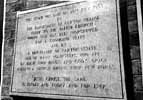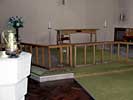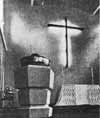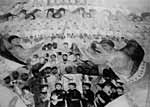 Clifton Clifton
St Francis
Features and Fittings
The Foundation Stone
It is fixed to the outside of the north wall of the nave, in capital letters.

This stone was laid on 26th July 1953
by
The blacksmith of Clifton village
Clerk to the Parish Church
Where God has been worshipped
For a thousand years
and by
A bricklayer of Clifton Estate
One of the many volunteers who are
By their own hands and God’s Grace
Building a church among their new homes.
“Jesus Christ the same
Yesterday and today and for ever”. |
Altar
 Altar and altar rails Altar and altar rails
in 2009 |
This is a table made from timber donated by the Headmistress of a Clifton school. It was designed by the leader of the voluntary builders and made at the Portland Training College for the Disabled. It is normally
covered with a white and gold cloth representing wind, fire and flowing water, and was designed by John Fox at the Royal College of Art, London.
Surrounded by light oak altar rails.
Font
 Font, cross and Font, cross and
altar (1957) |
The plain stone font, hexagonal in shape with an incised cross on one face, was designed by the architect Vernon Royle. It is set on a wide base with two sections above that, the top one being much bigger. The brass bowl came from a private Victorian house.
Lectern/Pulpit
This fitting made by Farnborough School served a dual purpose. On a brick base, made of light-coloured oak with metal rails, bearing on the front ‘the sword of the Spirit’, which was in fact a real weapon made by the Wilkinson Sword Company.
Pews
Plain benches in light oak, either side of a central aisle. They were provided by the firm that made them at cost price.
The Cross
This plain cross of West African hardwood ‘floats’ against the plain east wall. It was presented by the Headmistress of another Clifton school and made by the woodwork instructor at the Portland Training College. He completed it by adding strip lighting along the back of it.
There was also a wooden processional cross.
Crown of thorns
It was made of Perspex and designed by Leslie Durbin of London. The Rev. Stephen Verney and his wife presented it to the church.
Statue of St. Francis
This wooden statue dates from about 1620 and is possibly from Spain. It stands on a plinth above eye level on the west wall and is about 4 feet tall with a flat back.
It was found in an antiques shop in Hertford and restored by S. W. Wolsey in London. The Franciscan habit and the stigmata are evidence that it is of St. Francis. The right hand and foot were missing so have been replaced.
The Angels in the porch
Originally either side of the entrance but not to be seen now. Again they were a gift from an antiques shop, this time on Castle Place, Nottingham. The dealer believed one was from a medieval church, the other a Victorian copy. They were re-gilded before use in church.
The Bishop’s Chair
Said to be designed by Count Bernadotte of Sweden, the U.N. delegate murdered near Jerusalem.
The Pictures
Of unknown origin, bought in a sale and presented to the church. Maybe 17th century, they hung in the side chapel. They represent:
- The Agony in the Garden
- The Nailing to the Cross
- The Taking down from the Cross
- The Laying in the Tomb
At the west end hung a painting of the Virgin Mary with Jesus and his cousin John the Baptist in a peaceful scene which shows an Italian background. The painter is unknown, but almost certainly an Italian who painted it in the 16th century.
There are framed photographs of the first eleven incumbents hanging on the south wall of the main entrance hall, outside the nave.
Two high tables in light oak, one made at Portland Training College in 1953, the other by boys of Farnborough School in 1957.
Two prayer desks.
Two second-hand wardens’ staves.
Credence table fixed to the wall.
In November 1989 St. Augustine’s offered an aumbry, and a faculty was granted for it to be installed above the credence table. It was dedicated in March 1990 for the Reserved Sacrament.
Sedilia seating three fixed in the sanctuary.
There is an Alpha and Omega carving in the floor of the aisle. Also a consecration mark in the floor behind the high altar.
The Tapestry
This was designed by Norah Gibson, a teacher of biology at West Bridgford Grammar School, and made by her with help from other parishioners. It lay round the altar in six pieces. The one on the left represented the beginnings of life, the second related the story of animals and birds on land, the third the apex of organic evolution and the fourth part attempts to show Man’s position in the whole scheme. That Man becomes Adam and his family in the fifth piece. The last piece depicts Man pitting his strength against nature’s might. All six pieces had to be removed from the church to prevent water damage.
The tapestry kneelers were made by a lady in Nottingham. The formal designs were taken from Southwell Minster and the colourful scenes from the Bible were designed by her children. These kneelers have now been removed to prevent water damage.
The ceiling painting
 'The Company of 'The Company of
Heaven' painting |
Titled ‘The Company of Heaven’ this was painted by Pamela Lloyd when she was a student at the Royal College of Art. It occupies the central section of the ceiling and portrays scores of figures from the Bible, Saints and Angels and even two boys from the parish, Brian Howley and Ian Birch, who died while the mural was being painted. Also included is a portrayal of Sir Edmund Verney, Standard Bearer to Charles I, because he was an ancestor of the first minister, Stephen Verney. Blue was used a great deal in the painting and the rest of the ceiling was covered in blue to tone in. The general effect was to show a throng of earthly and heavenly worshippers moving joyously towards the cross.
Sadly the painting was, in 2013, seriously threatened by water ingress.
|